Regulatory signs inform the drivers of important roadway rules that they must obey. These signs include warning of potential dangers, directions, information and services. All drivers must be aware of what all of the colors and symbols mean in order to make responsible and quick decisions.
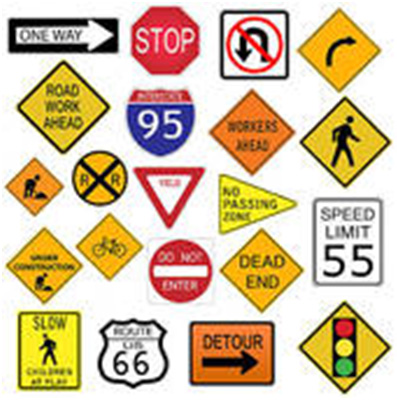
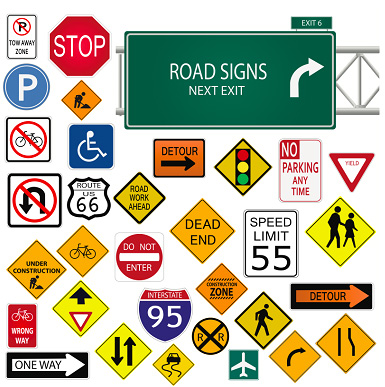
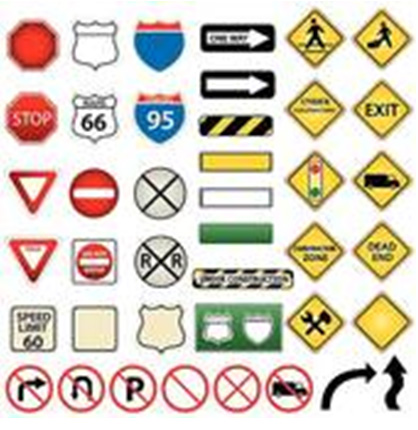
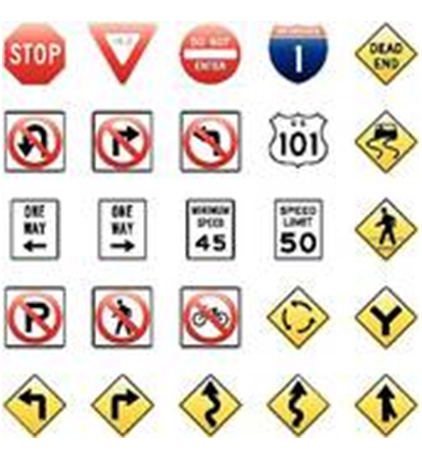
Stop Sign is white on red and its shape is octagon.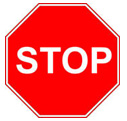
- This sign means that you must make a complete stop before entering a crosswalk, passing the limit line or entering the intersection.
- If no crosswalk or limit line is marked, you must stop at the corner.
- You must give the right-of-way to all vehicles and pedestrians who arrived before you at the intersection or who are currently in the intersection.
- On divided highways, a STOP sign for crossing or turning vehicles is often placed on the island or dividing strip. You must also stop for these signs.
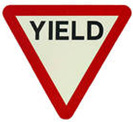 This sign means that you must slow down and be ready to stop and let other traffic (including pedestrians and bicycles) have the right-of-way before you continue driving.
This sign means that you must slow down and be ready to stop and let other traffic (including pedestrians and bicycles) have the right-of-way before you continue driving.
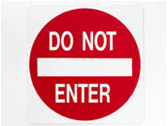 The DO NOT ENTER sign tells you that there is danger ahead because vehicles will be coming toward you. It is usually found on a freeway off ramp.
The DO NOT ENTER sign tells you that there is danger ahead because vehicles will be coming toward you. It is usually found on a freeway off ramp.
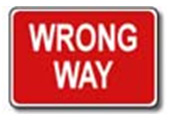 The WRONG WAY sign tells you that you are traveling the opposite direction of traffic in the lane. This sign are often placed together with the DO NOT ENTER sign or on freeway on and off ramps. If you see either of these signs drive to the side of the road and stop. When safe, back out or turn around and go back to the road you were originally on.
The WRONG WAY sign tells you that you are traveling the opposite direction of traffic in the lane. This sign are often placed together with the DO NOT ENTER sign or on freeway on and off ramps. If you see either of these signs drive to the side of the road and stop. When safe, back out or turn around and go back to the road you were originally on.
![]() This sign means that traffic on the road travels only in the direction that the arrow is pointing.
This sign means that traffic on the road travels only in the direction that the arrow is pointing.
No Right Turn, No Left Turn, No U Turn
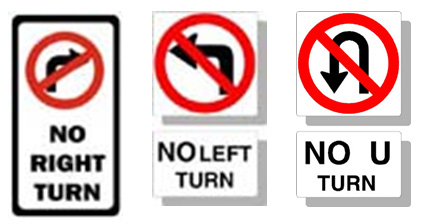 The driver must obey these signs. These signs are square in shape. With an additional horizontal rectangle sign, attached to the bottom of the square sign. This area is usually is where the words are displayed of what the driver should not do.
The driver must obey these signs. These signs are square in shape. With an additional horizontal rectangle sign, attached to the bottom of the square sign. This area is usually is where the words are displayed of what the driver should not do.
Most parking-related signs are also regulatory and must be obeyed
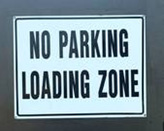
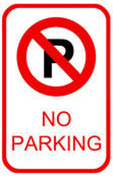
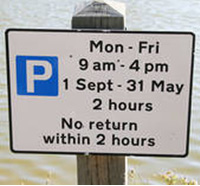
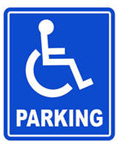
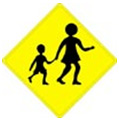
 This warning sign indicates that there may be pedestrians crossing the roadway ahead. You should slow down, look carefully for pedestrians crossing or about to cross the road and yield the right-of-way to pedestrians crossing.
This warning sign indicates that there may be pedestrians crossing the roadway ahead. You should slow down, look carefully for pedestrians crossing or about to cross the road and yield the right-of-way to pedestrians crossing.
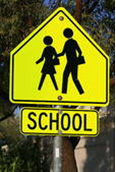 A number of warning signs are related to schools and playgrounds. You should slow down and carefully watch for children who might enter or cross the road. Speed signs are often posted along with these signs.
A number of warning signs are related to schools and playgrounds. You should slow down and carefully watch for children who might enter or cross the road. Speed signs are often posted along with these signs.
Warning signs alert you to potential dangers ahead and changes in the road conditions.
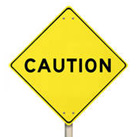 All warning signs must also be obeyed. Most warning signs are yellow and shaped like a diamond.
All warning signs must also be obeyed. Most warning signs are yellow and shaped like a diamond.
Below are some examples of warning signs.
 A diamond yellow sign with a big black “+”, this tells a driver that another road will intersect with their road. Warning to be cautious of traffic pulling out or crossing the road
A diamond yellow sign with a big black “+”, this tells a driver that another road will intersect with their road. Warning to be cautious of traffic pulling out or crossing the road
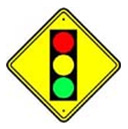 A diamond yellow sign, which depicts a traffic light on it, tells the driver that there is a traffic signal ahead. Prepare to stop.
A diamond yellow sign, which depicts a traffic light on it, tells the driver that there is a traffic signal ahead. Prepare to stop.
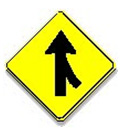 A diamond yellow sign with an arrow going one way and another line going through an arrow, tells the driver that another lane of traffic will be merging with their lane.
A diamond yellow sign with an arrow going one way and another line going through an arrow, tells the driver that another lane of traffic will be merging with their lane.
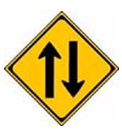 A diamond yellow sign that depicts two straight arrows, one pointing up and one pointing down, inform the driver of TWO WAY TRAFFIC ahead. (Sometimes this sign may have the words stated below the diamond on the sign, on a horizontal rectangle sign.)
A diamond yellow sign that depicts two straight arrows, one pointing up and one pointing down, inform the driver of TWO WAY TRAFFIC ahead. (Sometimes this sign may have the words stated below the diamond on the sign, on a horizontal rectangle sign.)
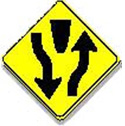 A diamond yellow sign that says END DIVIDED ROAD, indicates that the median or wall will end and that the lanes will be directly opposing each other.
A diamond yellow sign that says END DIVIDED ROAD, indicates that the median or wall will end and that the lanes will be directly opposing each other.
Guide and information signs inform you of services, recreation areas and destination information.

The orange construction signs inform drivers of construction zones ahead.
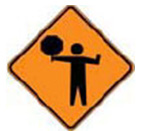 Some signs depict lane closures, speed reduction, slow, ramp closures, detours, detour routes, date and times of closures, work
Some signs depict lane closures, speed reduction, slow, ramp closures, detours, detour routes, date and times of closures, work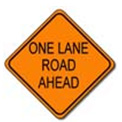 crews, etc. Orange cones on the road also warn the drivers that areas may be blocked to traffic due to construction or maintenance.
crews, etc. Orange cones on the road also warn the drivers that areas may be blocked to traffic due to construction or maintenance.
Note: Drivers must watch for trucks with flashing white arrows, these indicate to drivers that a work crew is either working in a lane and that the drivers need to merge into the appropriate lane. A driver needs to be especially cautious around construction and maintenance areas, due to the work crews being on or just off the road. It is highly dangerous work to the workers, if drivers do not obey the construction and maintenance signs.
Safety Tips for Work Zone
Work zones can be very dangerous for all vehicles especially when traveling on the highway. It is important to be alert and be prepared to slow down or stop in a work zone. Slowing down and allowing others to merge, will ensure a safe passage through work zones.
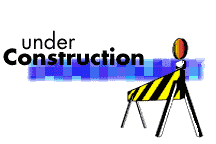
The following are few tips on work zone safety.
- Work zones are busy places where construction vehicles and workers are always moving. Stay alert and stay on the safe path that is designated throughout the work zone. Try to avoid work zones altogether by using alternate routes when possible. If you can’t avoid work zones, allow for more time to travel, slow down and consider sharing a ride with someone to reduce congestion.
- Work zones often pop up suddenly. If you are not paying attention to the signs, you could find yourself in a serious collision. Trucks can be great indicators of trouble or slow downs ahead. Trucks have a height advantage and can see ahead of traffic. Paying attention to a truck’s brake lights is a good signal of a slow down or work zone ahead. Truck drivers know the stopping limitations of their trucks, and pay close attention to traffic. Take your cues from trucks and you’ll be prepared.
- Aggressive drivers can be extremely dangerous while driving in work zones. Work zones require time and courtesy. For a smooth passage through work zones, allow others to merge in front of you. Be especially considerate to trucks. They require more space to merge and are the least maneuverable vehicles on the road. Remember, trucks have large blind spots, making it difficult to see cars squeezing in close to the front and sides of their truck.

